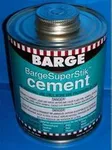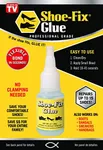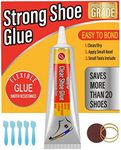Buying Guide for the Best Glue To Repair Shoes
Choosing the right glue for repairing shoes can make a big difference in how long your repair lasts and how good it looks. Not all glues are created equal, and different types are better suited for different shoe materials and types of repairs. Before buying, think about what part of the shoe you need to fix, what materials your shoes are made from, and how much flexibility and durability you need from the repair. Understanding the key features of shoe glues will help you pick the best one for your needs.Type of GlueThe type of glue refers to the chemical composition and intended use of the adhesive. Common types for shoe repair include contact cement, super glue (cyanoacrylate), and urethane-based adhesives. Contact cement is flexible and strong, making it good for bonding soles and leather. Super glue dries quickly and is best for small, rigid repairs. Urethane-based adhesives are highly durable and waterproof, suitable for heavy-duty repairs. To choose the right type, consider the materials you are bonding and whether you need flexibility or a quick fix.
Flexibility After DryingFlexibility after drying means how much the glue can bend or move once it has set. Shoes naturally flex as you walk, so a glue that dries too hard can crack and fail. Glues that remain flexible are better for areas that bend, like the sole or upper. If you are repairing a part of the shoe that moves a lot, look for a glue that advertises flexibility. For rigid parts, like a heel, flexibility is less important.
Water ResistanceWater resistance is the glue’s ability to withstand exposure to moisture without breaking down. Shoes are often exposed to rain, puddles, or sweat, so a water-resistant glue will help your repair last longer. Some glues are labeled as waterproof, while others are only water-resistant. If you plan to wear the shoes outdoors or in wet conditions, prioritize a glue with strong water resistance.
Drying and Curing TimeDrying and curing time refers to how long it takes for the glue to set and reach its full strength. Some glues bond in seconds, while others need several hours or even overnight to cure completely. Fast-drying glues are convenient for quick fixes, but slower-curing glues often create a stronger, more durable bond. If you need to use your shoes soon, a quick-drying glue may be best, but for a long-lasting repair, be patient and allow for full curing.
Bond StrengthBond strength is how well the glue holds the materials together once it has set. Stronger bonds are important for high-stress areas like soles or heels, while lighter bonds may be enough for minor repairs. Glues designed specifically for shoes usually offer higher bond strength. Think about how much stress the repaired area will face and choose a glue that matches those demands.
Ease of ApplicationEase of application describes how simple it is to use the glue, including how it is dispensed and whether it is messy. Some glues come with applicator tips or brushes for precise use, while others may be harder to control. If you are new to shoe repair or working on a small area, look for a glue that is easy to apply and clean up.














